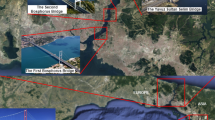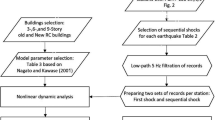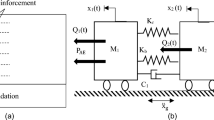Abstract
Bearings acts as fusing components in bridges and transfer loads from superstructures to substructures. During earthquakes, bridge bearings may be subjected to large axial compressive loads and lateral displacements, and consequently experience severe damages. In this paper, an input energy-based (IEB) and a sliding displacement-based (SDB) damage index are proposed for quantifying seismic damage of the bridge bearings. The IEB damage index, previously proposed by authors, as the ratio of the dissipated energy to the earthquake input energy, and the SDB damage index is defined considering yielding displacement of the bearings corresponding to their sliding threshold. To evaluate the ability of the proposed damage indices in damage assessment of the bridge bearings, the force–displacement behavior of three commonly used bearings including elastomeric bearing, lead–rubber bearing, and flat sliding bearing are developed using rheological models. A set of the bearing specimens experimentally tested under cyclic/seismic loadings is adopted to calibrate the reliability of the damage indices. The results show that the IEB damage index provides a reasonably gradual progression of damage throughout the loading history and gives acceptable values for sliding and failure damage levels of the bearings more convincingly than the SDB damage model with respect to the experiment observations.
















Similar content being viewed by others
References
AASHTO (2014) Guide specifications for seismic isolation design, 4th edn. American Association of State Highway and Transportation Officials, Washington, DC
Banerjee S, Shinozuka M (2008) Experimental verification of bridge seismic damage states quantified by calibrating analytical models with empirical field data. Earthq Eng Eng Vib 7:383–393
Basoz N, Kiremidjian AS (1999) Evaluation of bridge damage data from recent earthquakes. Earthq Spectra 15(1):25–53
Bassam A, Iranmanesh A, Ansari F (2011) A simple quantitative approach for post-earthquake damage assessment of flexure dominant reinforced concrete bridges. Eng Struct 33:3218–3225
Benavent-Climent A (2007) An energy-based damage model for seismic response of steel structures. Earthq Eng Struct Dyn 36(8):1049–1064
Benavent-Climent A (2011) An energy-based method for seismic retrofit of existing frames using hysteretic dampers. Soil Dyn Earthq Eng 31:1385–1396
Benzoni G, Casarotti C (2009) Effects of vertical load, strain rate and cycling on the response of lead–rubber seismic isolators. J Earthq Eng 13(3):293–312
Calvi GM, Ceresa P, Casarotti C, Bolognini D, Auricchio F (2004) Effects of axial force variation in the seismic response of bridges isolated with friction pendulum systems. J Earthq Eng. https://doi.org/10.1080/13632460409350525
Cardone D (2014) Displacement limits and performance displacement profiles in support of direct displacement-based seismic assessment of bridges. Earthq Eng Struct Dyn 3:1239–1263
Casarotti C (2004) Bridge isolation and dissipation devices: state of the art review of seismic response and modeling of modern seismic isolation and dissipation devices (master degree thesis). European School for Advanced Studies in Reduction of seismic Risk, Pavia
Dicleli M (2002) Seismic design of lifeline bridge using hybrid seismic isolation. J Bridge Eng 7(2):94–103
Endo K, Okada T, Unjoh S (2008) Shaking table test of bridge isolated by sliding bearings. Struct Eng Earthq Eng JSCE 255(2):60–74
English BA, Klingner RE, Yura JA (1994) Research report no. 1304-1: elastomeric bearings: background information and filed study, Texas Department of Transportation
Eroz M, DesRoches R (2013) A comparative assessment of sliding and elastomeric seismic isolation in a typical multi-span bridge. J Earthq Eng 17:637–657
Forcellini D (2016) 3D numerical simulations of elastomeric bearings for bridges. Innov Infrastruct Solut 1:45. https://doi.org/10.1007/s41062-016-0045-4
Furinghetti M, Pavese A (2017) Equivalent uniaxial accelerogram for CSS-based isolation systems assessment under two-components seismic events. Mech Based Des Struct Mach. https://doi.org/10.1080/15397734.2017.1281145
Furinghetti M, Pavese A, Quaglini V, Dubini P (2019) Experimental investigation of the cyclic response of double curved surface sliders subjected to radial and bidirectional sliding motions. Soil Dyn Earthq Eng. https://doi.org/10.1016/j.soildyn.2018.11.020
Galindo CM, Spuler T, Moor G, Stirnimann F (2012) Design, full-scale testing and CE certification of anti-seismic devices according to the New European Norm EN 15129: elastomeric isolators. Paper presented at the proceeding of 15th world conference on earthquake engineering, Lisbon, Portugal
Ghobrah A, Abou-Elfath H, Biddah A (1999) Response based damage assessment of structures. Earthq Eng Struct Dyn 28:79–104
Hachem MM, Stephan AM, Moehle JP (2003) Performance of circular reinforce concrete bridge columns under bidirectional earthquake loading. PEER rep. 2003/06, Pacific Earthquake Engineering Research Center College of Engineering University of California. Berkeley, CA
Han X (2013) An analytical model for simulating the critical behavior of elastomeric seismic isolation bearings. Ph.D. thesis, Pennsylvania State University
Hindi RA, Sexsmith RG (2004) Inelastic damage analysis of reinforced concrete bridge columns based on degraded monotonic energy. J Bridge Eng 9(6):326–332
Hose Y, Silva P, Seible F (2000) Development of a performance evaluation database for concrete bridge components and systems under simulated seismic loads. Earthq Spectra 16(2):413–442
Jara JM, Lopez MG, Jara M, Olmos BA (2014) Rotation and damage index demands for RC medium-length span bridges. Eng Struct 75:205–217
Konstantinidis D, Kelly JM, Makris N (2008) Seismic response of bridge bearings. Report no. EERC-2008/02, Earthquake Engineering Research Center, University of California, Berkeley, CA
Kumar M, Whittaker AS, Constantinou MC (2015) Response of base-isolated nuclear structures to extreme earthquake shaking. Nucl Eng Des 295:860–874
Kwon OS, Elnashai AS (2010) Fragility analysis of a highway over-crossing bridge with consideration of soil–structure interactions. Struct Infrastruct Eng 6:159–178
LaFave J, Fahnestock L, Foutch D, Steelman J, Revell J, Filipov E et al (2013) Experimental investigation of the seismic response of bridge bearings. Research report no. ICT-13-002, Illinois Center for Transportation, Univ. of Illinois at Urbana-Champaign, Urbana, IL
Lee D, Constantinou M (2015) Further results on the heating of single and multi-core lead–rubber bearings and dampers. Bull Earthq Eng 14:999–1016
Lu X, Wang D, Shanshan W (2016) Investigation of the seismic response of high-rise buildings supported on tension-resistant elastomeric isolation bearings. Earthq Eng Struct Dyn 45:2207–2228
Mackie KR, Stojadinovic B (2005) Fragility basis for California highway overpass bridge seismic decision making. PEER rep. 2005/12, Pacific Earthquake Engineering Research Center College of Engineering University of California. Berkeley, CA
Mahboubi S, Shiravand MR (2019a) A proposed input energy-based damage index for RC bridge piers. J Bridge Eng 24(1):1–19. https://doi.org/10.1061/(ASCE)BE.1943-5592.0001326
Mahboubi S, Shiravand MR (2019b) Failure assessment of skew RC bridges with FRP piers based on damage indices. Eng Fail Anal. https://doi.org/10.1016/j.engfailanal.2019.02.010
Mtenga PV (2007) Elastomeric bearing pad under combined loading. Ph.D. thesis, Florida Department of Transportation, Tallahassee, Florida
Naiem F, Kelly M (1997) Design of seismic isolated structures. Wiley, New York
Nielson BG (2005) Analytical fragility curves for highway bridges in moderate seismic zones. Ph.D. thesis, Georgia Institute of Technology
Padgett JM (2007) Seismic vulnerability assessment of retrofitted bridges using probabilistic methods. Ph.D. thesis, Georgia Institute of Technology
Park YJ, Ang AH (1985) Mechanistic seismic damage model for reinforced concrete. J Struct Eng 111:722–739
Pavese A, Furinghetti M, Casarotti C (2018) Experimental assessment of the cyclic response of friction-based isolators under bidirectional motions. Soil Dyn Earthq Eng. https://doi.org/10.1016/j.soildyn.2018.06.031
Powell GH, Allahabadi R (1988) Seismic damage prediction by deterministic methods: concepts and procedures. Earthq Eng Struct Dyn 16(5):719–734
Rajeev P, Wijesundara KK (2014) Energy-based damage index for concentrically braced steel structure using continuous wavelet transform. J Constr Steel Res 103:241–250
Ramanathan K, Padgett JM, DesRoches R (2015) Temporal evolution of seismic fragility curves for concrete box-girder bridges in California. Eng Struct 97:29–46
Russo G, Pauletta M (2013) Sliding instability of fiber-reinforced elastomeric isolators in unbonded applications. Eng Struct 48:70–80
Sanchez J, Masroor A, Mosqueda A, Ryan K (2013) Static and dynamic stability of elastomeric bearings for seismic protection of structures. J Struct Eng 139:1149–1159
Shiravand MR, Parvenehro P (2019) Spatial variation of seismic ground motion effects on nonlinear responses of cable stayed bridges considering different soil types. Soil Dyn Earthq Eng. https://doi.org/10.1016/j.soildyn.2019.01.002
Shiravand MR, Rasouli M (2019) Effects of substructure mass participation on natural period of multi-column base isolated bridges. Structures 20:88–104. https://doi.org/10.1016/j.istruc.2019.03.002
Steelman JS, Fahnestock LA, Filipov ET, LaFave JM, Hajjar JF, Foutch DA (2013) Shear and friction response of nonseismic laminated elastomeric bridge bearings subject to seismic demands. J Bridge Eng 18(12):612–623
Steelman JS, Filipov ET, Fahnestock LA, Revell JR, LaFave JM, Hajjar JF, Foutch DA (2014) Experimental behavior of steel fixed bearings and implications for seismic bridge response. J Bridge Eng. https://doi.org/10.1061/(asce)BE.1943-5592.0000540
Steelman JS, Fahnestock LA, Hajjar JF, LaFave JM (2016) Performance of non-seismic PTFE sliding bearings when subjected to seismic demands. J Bridge Eng. https://doi.org/10.1061/(ASCE)BE.1943-5592.0000777
Stone WC, Taylor AW (1992) A predictive model for hysteretic failure parameters. Paper presented at proceeding of 10th world conference on earthquake engineering. A.A Balkema, Rotterdam, Netherlands
Weisman J, Warn GP (2012) Stability of elastomeric and lead–rubber seismic isolation bearings. J Struct Eng 138:215–223
Zhou T, Wu FY, Li AQ (2017) Implementation and validation of numerical model for lead–rubber seismic isolation bearings. J Mech. https://doi.org/10.1017/jmech.2017.100
Author information
Authors and Affiliations
Corresponding author
Additional information
Publisher's Note
Springer Nature remains neutral with regard to jurisdictional claims in published maps and institutional affiliations.
Rights and permissions
About this article
Cite this article
Mahboubi, S., Shiravand, M.R. Seismic evaluation of bridge bearings based on damage index. Bull Earthquake Eng 17, 4269–4297 (2019). https://doi.org/10.1007/s10518-019-00614-3
Received:
Accepted:
Published:
Issue Date:
DOI: https://doi.org/10.1007/s10518-019-00614-3




